Golnaz Ghiasi
HaloQuest: A Visual Hallucination Dataset for Advancing Multimodal Reasoning
Jul 22, 2024Abstract:Hallucination has been a major problem for large language models and remains a critical challenge when it comes to multimodality in which vision-language models (VLMs) have to deal with not just textual but also visual inputs. Despite rapid progress in VLMs, resources for evaluating and addressing multimodal hallucination are limited and mostly focused on evaluation. This work introduces HaloQuest, a novel visual question answering dataset that captures various aspects of multimodal hallucination such as false premises, insufficient contexts, and visual challenges. A novel idea from HaloQuest is to leverage synthetic images, apart from real ones, to enable dataset creation at scale. With over 7.7K examples spanning across a wide variety of categories, HaloQuest was designed to be both a challenging benchmark for VLMs and a fine-tuning dataset for advancing multimodal reasoning. Our experiments reveal that current models struggle with HaloQuest, with all open-source VLMs achieving below 36% accuracy. On the other hand, fine-tuning on HaloQuest significantly reduces hallucination rates while preserving performance on standard reasoning tasks. Our results discover that benchmarking with generated images is highly correlated (r=0.97) with real images. Last but not least, we propose a novel Auto-Eval mechanism that is highly correlated with human raters (r=0.99) for evaluating VLMs. In sum, this work makes concrete strides towards understanding, evaluating, and mitigating hallucination in VLMs, serving as an important step towards more reliable multimodal AI systems in the future.
DaTaSeg: Taming a Universal Multi-Dataset Multi-Task Segmentation Model
Jun 02, 2023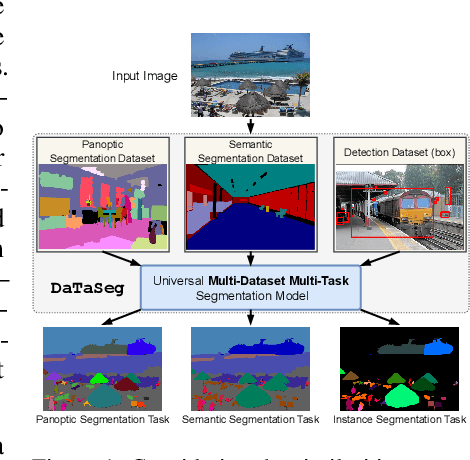



Abstract:Observing the close relationship among panoptic, semantic and instance segmentation tasks, we propose to train a universal multi-dataset multi-task segmentation model: DaTaSeg.We use a shared representation (mask proposals with class predictions) for all tasks. To tackle task discrepancy, we adopt different merge operations and post-processing for different tasks. We also leverage weak-supervision, allowing our segmentation model to benefit from cheaper bounding box annotations. To share knowledge across datasets, we use text embeddings from the same semantic embedding space as classifiers and share all network parameters among datasets. We train DaTaSeg on ADE semantic, COCO panoptic, and Objects365 detection datasets. DaTaSeg improves performance on all datasets, especially small-scale datasets, achieving 54.0 mIoU on ADE semantic and 53.5 PQ on COCO panoptic. DaTaSeg also enables weakly-supervised knowledge transfer on ADE panoptic and Objects365 instance segmentation. Experiments show DaTaSeg scales with the number of training datasets and enables open-vocabulary segmentation through direct transfer. In addition, we annotate an Objects365 instance segmentation set of 1,000 images and will release it as a public benchmark.
Revisiting Multi-Scale Feature Fusion for Semantic Segmentation
Mar 23, 2022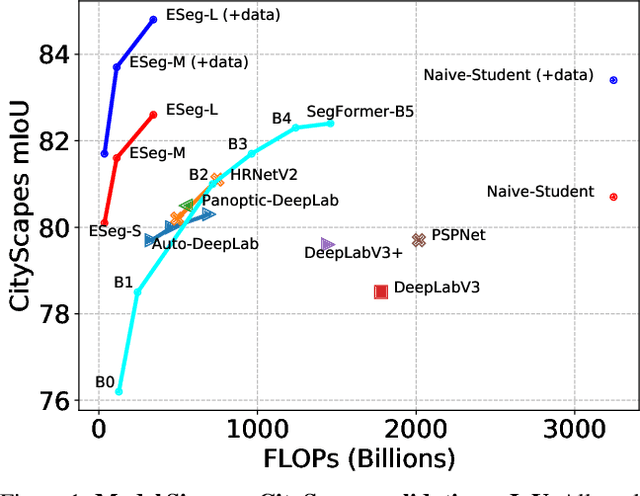

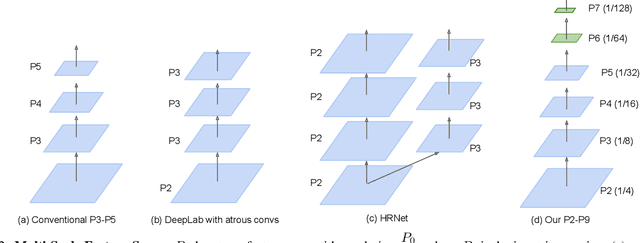

Abstract:It is commonly believed that high internal resolution combined with expensive operations (e.g. atrous convolutions) are necessary for accurate semantic segmentation, resulting in slow speed and large memory usage. In this paper, we question this belief and demonstrate that neither high internal resolution nor atrous convolutions are necessary. Our intuition is that although segmentation is a dense per-pixel prediction task, the semantics of each pixel often depend on both nearby neighbors and far-away context; therefore, a more powerful multi-scale feature fusion network plays a critical role. Following this intuition, we revisit the conventional multi-scale feature space (typically capped at P5) and extend it to a much richer space, up to P9, where the smallest features are only 1/512 of the input size and thus have very large receptive fields. To process such a rich feature space, we leverage the recent BiFPN to fuse the multi-scale features. Based on these insights, we develop a simplified segmentation model, named ESeg, which has neither high internal resolution nor expensive atrous convolutions. Perhaps surprisingly, our simple method can achieve better accuracy with faster speed than prior art across multiple datasets. In real-time settings, ESeg-Lite-S achieves 76.0% mIoU on CityScapes [12] at 189 FPS, outperforming FasterSeg [9] (73.1% mIoU at 170 FPS). Our ESeg-Lite-L runs at 79 FPS and achieves 80.1% mIoU, largely closing the gap between real-time and high-performance segmentation models.
Open-Vocabulary Image Segmentation
Dec 22, 2021



Abstract:We design an open-vocabulary image segmentation model to organize an image into meaningful regions indicated by arbitrary texts. We identify that recent open-vocabulary models can not localize visual concepts well despite recognizing what are in an image. We argue that these models miss an important step of visual grouping, which organizes pixels into groups before learning visual-semantic alignments. We propose OpenSeg to address the above issue. First, it learns to propose segmentation masks for possible organizations. Then it learns visual-semantic alignments by aligning each word in a caption to one or a few predicted masks. We find the mask representations are the key to support learning from captions, making it possible to scale up the dataset and vocabulary sizes. Our work is the first to perform zero-shot transfer on holdout segmentation datasets. We set up two strong baselines by applying class activation maps or fine-tuning with pixel-wise labels on a pre-trained ALIGN model. OpenSeg outperforms these baselines by 3.4 mIoU on PASCAL-Context (459 classes) and 2.7 mIoU on ADE-20k (847 classes).
Combined Scaling for Zero-shot Transfer Learning
Nov 19, 2021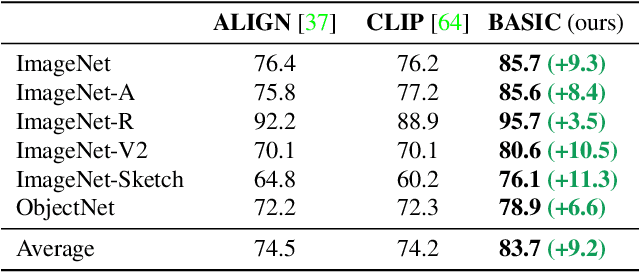
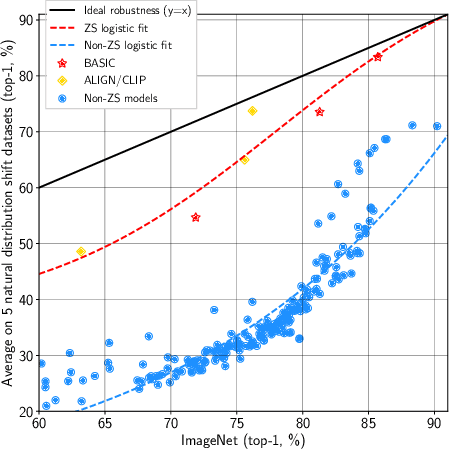


Abstract:We present a combined scaling method called BASIC that achieves 85.7% top-1 zero-shot accuracy on the ImageNet ILSVRC-2012 validation set, surpassing the best-published zero-shot models - CLIP and ALIGN - by 9.3%. Our BASIC model also shows significant improvements in robustness benchmarks. For instance, on 5 test sets with natural distribution shifts such as ImageNet-{A,R,V2,Sketch} and ObjectNet, our model achieves 83.7% top-1 average accuracy, only a small drop from the its original ImageNet accuracy. To achieve these results, we scale up the contrastive learning framework of CLIP and ALIGN in three dimensions: data size, model size, and batch size. Our dataset has 6.6B noisy image-text pairs, which is 4x larger than ALIGN, and 16x larger than CLIP. Our largest model has 3B weights, which is 3.75x larger in parameters and 8x larger in FLOPs than ALIGN and CLIP. Our batch size is 65536 which is 2x more than CLIP and 4x more than ALIGN. The main challenge with scaling is the limited memory of our accelerators such as GPUs and TPUs. We hence propose a simple method of online gradient caching to overcome this limit.
Multi-Task Self-Training for Learning General Representations
Aug 25, 2021



Abstract:Despite the fast progress in training specialized models for various tasks, learning a single general model that works well for many tasks is still challenging for computer vision. Here we introduce multi-task self-training (MuST), which harnesses the knowledge in independent specialized teacher models (e.g., ImageNet model on classification) to train a single general student model. Our approach has three steps. First, we train specialized teachers independently on labeled datasets. We then use the specialized teachers to label an unlabeled dataset to create a multi-task pseudo labeled dataset. Finally, the dataset, which now contains pseudo labels from teacher models trained on different datasets/tasks, is then used to train a student model with multi-task learning. We evaluate the feature representations of the student model on 6 vision tasks including image recognition (classification, detection, segmentation)and 3D geometry estimation (depth and surface normal estimation). MuST is scalable with unlabeled or partially labeled datasets and outperforms both specialized supervised models and self-supervised models when training on large scale datasets. Lastly, we show MuST can improve upon already strong checkpoints trained with billions of examples. The results suggest self-training is a promising direction to aggregate labeled and unlabeled training data for learning general feature representations.
Gradual Domain Adaptation in the Wild:When Intermediate Distributions are Absent
Jun 10, 2021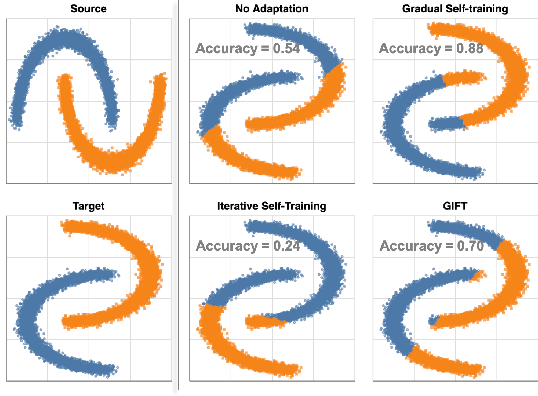


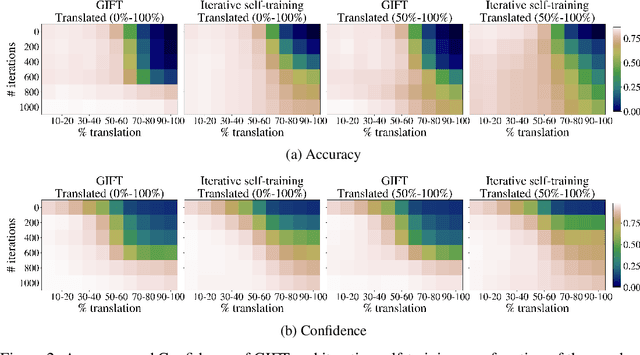
Abstract:We focus on the problem of domain adaptation when the goal is shifting the model towards the target distribution, rather than learning domain invariant representations. It has been shown that under the following two assumptions: (a) access to samples from intermediate distributions, and (b) samples being annotated with the amount of change from the source distribution, self-training can be successfully applied on gradually shifted samples to adapt the model toward the target distribution. We hypothesize having (a) is enough to enable iterative self-training to slowly adapt the model to the target distribution, by making use of an implicit curriculum. In the case where (a) does not hold, we observe that iterative self-training falls short. We propose GIFT, a method that creates virtual samples from intermediate distributions by interpolating representations of examples from source and target domains. We evaluate an iterative-self-training method on datasets with natural distribution shifts, and show that when applied on top of other domain adaptation methods, it improves the performance of the model on the target dataset. We run an analysis on a synthetic dataset to show that in the presence of (a) iterative-self-training naturally forms a curriculum of samples. Furthermore, we show that when (a) does not hold, GIFT performs better than iterative self-training.
Simple Copy-Paste is a Strong Data Augmentation Method for Instance Segmentation
Dec 13, 2020



Abstract:Building instance segmentation models that are data-efficient and can handle rare object categories is an important challenge in computer vision. Leveraging data augmentations is a promising direction towards addressing this challenge. Here, we perform a systematic study of the Copy-Paste augmentation ([13, 12]) for instance segmentation where we randomly paste objects onto an image. Prior studies on Copy-Paste relied on modeling the surrounding visual context for pasting the objects. However, we find that the simple mechanism of pasting objects randomly is good enough and can provide solid gains on top of strong baselines. Furthermore, we show Copy-Paste is additive with semi-supervised methods that leverage extra data through pseudo labeling (e.g. self-training). On COCO instance segmentation, we achieve 49.1 mask AP and 57.3 box AP, an improvement of +0.6 mask AP and +1.5 box AP over the previous state-of-the-art. We further demonstrate that Copy-Paste can lead to significant improvements on the LVIS benchmark. Our baseline model outperforms the LVIS 2020 Challenge winning entry by +3.6 mask AP on rare categories.
Rethinking Pre-training and Self-training
Jun 11, 2020



Abstract:Pre-training is a dominant paradigm in computer vision. For example, supervised ImageNet pre-training is commonly used to initialize the backbones of object detection and segmentation models. He et al., however, show a surprising result that ImageNet pre-training has limited impact on COCO object detection. Here we investigate self-training as another method to utilize additional data on the same setup and contrast it against ImageNet pre-training. Our study reveals the generality and flexibility of self-training with three additional insights: 1) stronger data augmentation and more labeled data further diminish the value of pre-training, 2) unlike pre-training, self-training is always helpful when using stronger data augmentation, in both low-data and high-data regimes, and 3) in the case that pre-training is helpful, self-training improves upon pre-training. For example, on the COCO object detection dataset, pre-training benefits when we use one fifth of the labeled data, and hurts accuracy when we use all labeled data. Self-training, on the other hand, shows positive improvements from +1.3 to +3.4AP across all dataset sizes. In other words, self-training works well exactly on the same setup that pre-training does not work (using ImageNet to help COCO). On the PASCAL segmentation dataset, which is a much smaller dataset than COCO, though pre-training does help significantly, self-training improves upon the pre-trained model. On COCO object detection, we achieve 54.3AP, an improvement of +1.5AP over the strongest SpineNet model. On PASCAL segmentation, we achieve 90.5 mIOU, an improvement of +1.5% mIOU over the previous state-of-the-art result by DeepLabv3+.
SpineNet: Learning Scale-Permuted Backbone for Recognition and Localization
Dec 10, 2019



Abstract:Convolutional neural networks typically encode an input image into a series of intermediate features with decreasing resolutions. While this structure is suited to classification tasks, it does not perform well for tasks requiring simultaneous recognition and localization (e.g., object detection). The encoder-decoder architectures are proposed to resolve this by applying a decoder network onto a backbone model designed for classification tasks. In this paper, we argue that encoder-decoder architecture is ineffective in generating strong multi-scale features because of the scale-decreased backbone. We propose SpineNet, a backbone with scale-permuted intermediate features and cross-scale connections that is learned on an object detection task by Neural Architecture Search. SpineNet achieves state-of-the-art performance of one-stage object detector on COCO with 60% less computation, and outperforms ResNet-FPN counterparts by 6% AP. SpineNet architecture can transfer to classification tasks, achieving 6% top-1 accuracy improvement on a challenging iNaturalist fine-grained dataset.
 Add to Chrome
Add to Chrome Add to Firefox
Add to Firefox Add to Edge
Add to Edge